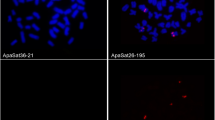Abstract
Satellites visible in female but not in male DNA were isolated from the snakesElaphe radiata (satellite IV, p = 1.708 g · cm−3) andBungarus fasciatus (BK1 minor, p=1.709 g · cm−3). The satellites cross hybridize. Hybridization of3H labelled nick translated BK minor satellite DNA with the total male and female DNA and/or chromosomes in situ of different species of snakes revealed that its sequences are conserved throughout the snake group and are mainly concentrated on the W chromosome. Snakes lacking sex chromosomes do possess related sequences but there is no sex difference and visible related satellites are absent. The following conclusions have been reached on the basis of these results. 1. The W chromosome associated satellite DNA is related to similar sequences scattered in the genome. 2. The origin and increment in the number of the W satellite DNA sequence on the W chromosome is associated with the heterochromatinization of the W. 3. Satellite sequences have become distributed along the length of the W and resulted in morphological differentiation of sex chromosomes. 4. Evolutionary conservation of W satellite DNA strongly suggests that functional constraints may have limited sequence divergence.
Similar content being viewed by others
References
Birnstiel, M.L., Sells, B.H., Purdom, I.F.: Kinetic complexity of RNA molecules. J. molec. Biol.63, 21–39 (1972)
Bowen, S.T.: The genetics of Artemia salina. V. Crossing-over between the X and Y chromosomes. Genetics52, 695–710 (1965)
Bull, J.J., Vogt, R.C.: Temperature-dependent sex determination in turtles. Science206, 1186–1188 (1979)
Charlesworth, B.: Model for evolution of Y chromosomes and dosage compensation. Proc. nat. Acad. Sci. (Wash.)75, 5618–5622 (1978)
Denhardt, D.T.: A membrane filter technique for the detection of complementary DNA. Biochem. biophys. Res. Comm.23, 641–646 (1966)
Gillespie, D., Spiegelman, S.: A quantitative assay for DNA-RNA hybrids with DNA immobilised on a membrane. J. molec. Biol.12, 829–842 (1965)
Gorman, G.C.: The chromosomes of the reptilia, a cytotaxonomic interpretation. In: Cytotaxonomy and vertebrate evolution (A.B. Chiarelli and E. Kapanna, eds.), pp. 350–424. New York: Academic Press 1973
Jensen, R.H., Davidson, N.: Spectrophotometric, potentiometric and density gradient ultracentrifugation studies of the binding of silver ion by DNA. Biopolymers4, 17–32 (1966)
Jones, K.W.: In situ hybridization. In: New technique in biophysics and cell biology (R.H. Pain and B.J. Smith, eds.), pp. 29–66, London: J. Wiley and Sons 1973
Keyl, H.G.: Duplikationen von Untereinheiten der chromosomalen DNS während der Evolution von Chironomus thummi. Chromosoma (Berl.),17, 139–180 (1965)
Maio, J.J., Brown, F.L., Musich, P.R.: Subunit structure of chromatin and the organization of eukaryotic highly repetitive DNA: Recurrent periodicities and models for the evolutionary origins of repetitive DNA. J. molec. Biol.117, 637–655 (1977)
Marmur, J.: A procedure for the isolation of deoxyribonucleic acid from microorganisms. J. molec. Biol.3, 208–218 (1961)
Muller, H.J.: A gene for the fourth chromosome of Drosophila. J. exp. Zool.17, 325–336 (1914)
Muller, H.J.: Genetic variability, twin hybrids and constant hybrids, in a case of balanced lethal factors. Genetics3, 422–499 (1918)
Ohno, S.: Sex chromosomes and sex-linked genes. Berlin-Heidelberg-New York: Springer 1967
Ray-Chaudhuri, S.P., Singh, L.: DNA replication pattern in sex-chromosomes of snakes. Nucleus (Calcutta)15, 200–210 (1972)
Ray-Chaudhuri, S.P., Singh, L., Sharma, T.: Sexual dimorphism in simatic interphase nuclei of snakes. Cytogenetics91, 410–423 (1970)
Ray-Chaudhuri, S.P., Singh, L., Sharma, T.: Evolution of sex chromosomes and formation of W chromatin in snakes. Chromosoma (Berl.)33, 239–251 (1971)
Rigby, P.W.J., Dieckmann, M., Rhodes, C., Berg, P.: Labelling deoxyribonucleic acid to high specific activity in vitro by nick translation with DNA polymerase I. J. molec. Biol.113, 237–251 (1977)
Salser, W., Bowen, S., Browne, D., El Adli, F., Fedoroff, N., Fry, K., Heindell, H., Paddock, G., Poon, R., Wallace, B., Whitcome, P.: Investigation of the organisation of mammalian chromosomes at the DNA sequence level. Fed. Proc.35, 23–35 (1976)
Schmid, M., Olert, J., Klett, C.: Chromosome banding in Amphibia. III. Sex chromosomes in Triturus. Chromosoma (Berl.)71, 29–55 1979)
Singh, L.: Evolution of karyotypes in snakes. Chromosoma (Berl.)38, 185–236 (1972 a)
Singh, L.: Multiple W chromosome in a sea snake, Enhydrina schistosa Daudin. Experientia (Basel)28, 95–97 (1972 b)
Singh, L.: Chromosomes of six species of Indian snakes. Herpetologica30, 419–429 (1974)
Singh, L.: Study of mitotic and meiotic chromosomes in seven species of lizards. Proc. Zool. Soc. Calcutta27, 57–79 (1974)
Singh, L., Sharma, T., Ray-Chaudhuri, S.P.: Chromosomes and the classification of snakes of the family Boidae. Cytogenetics7, 161–168 (1968 a)
Singh, L., Sharma, T., Ray-Chaudhuri, S.P.: W chromosome in the Indian water snake (checkered keel back) Natrix piscator (Colubridae). Experientia (Basel)24, 79–80 (1968 b)
Singh, L., Sharma, T., Ray-Chaudhuri, S.P.: Multiple sex-chromosomes in the common Indian krait, Bungarus caeruleus Schneider. Chromosoma (Berl.)31, 386–391 (1970)
Singh, L., Purdom, I.F., Jones, K.W.: Satellite DNA and evolution of sex chromosomes. Chromosoma (Berl.)59, 43–62 (1976)
Singh, L., Purdom, I.F., Jones, K.W.: Effect of different denaturing agents on the detectability of specific DNA sequences of various base compositions by in situ hybridization. Chromosoma (Berl.)60, 377–389 (1977)
Singh, L., Purdom, I.F., Jones, K.W.: Behaviour of sex chromosome associated satellite DNAs in somatic and germ cells in snakes. Chromosoma (Berl.)71, 167–181 (1979 a)
Singh, L., Ray-Chaudhuri, S.P., Majumdar, K., Purdom, I.F., Jones, K.W.: Sex specific chromosome polmorphisms in the common Indian krait, Bungarus caeruleus Schneider (Ophidia, Elapidae). Chromosoma (Berl.)73, 93–108 (1979 b)
Smith, G.P.: Evolution of repeated DNA sequences by unequal cross-overs. Science191, 528–535 (1976)
Sumner, A. T.: A simple technique for demonstrating contromeric heterochromatin. Exp. Cell Res.75, 304–306 (1972)
Author information
Authors and Affiliations
Rights and permissions
About this article
Cite this article
Singh, L., Purdom, I.F. & Jones, K.W. Sex chromosome associated satellite DNA: Evolution and conservation. Chromosoma 79, 137–157 (1980). https://doi.org/10.1007/BF01175181
Received:
Accepted:
Issue Date:
DOI: https://doi.org/10.1007/BF01175181




